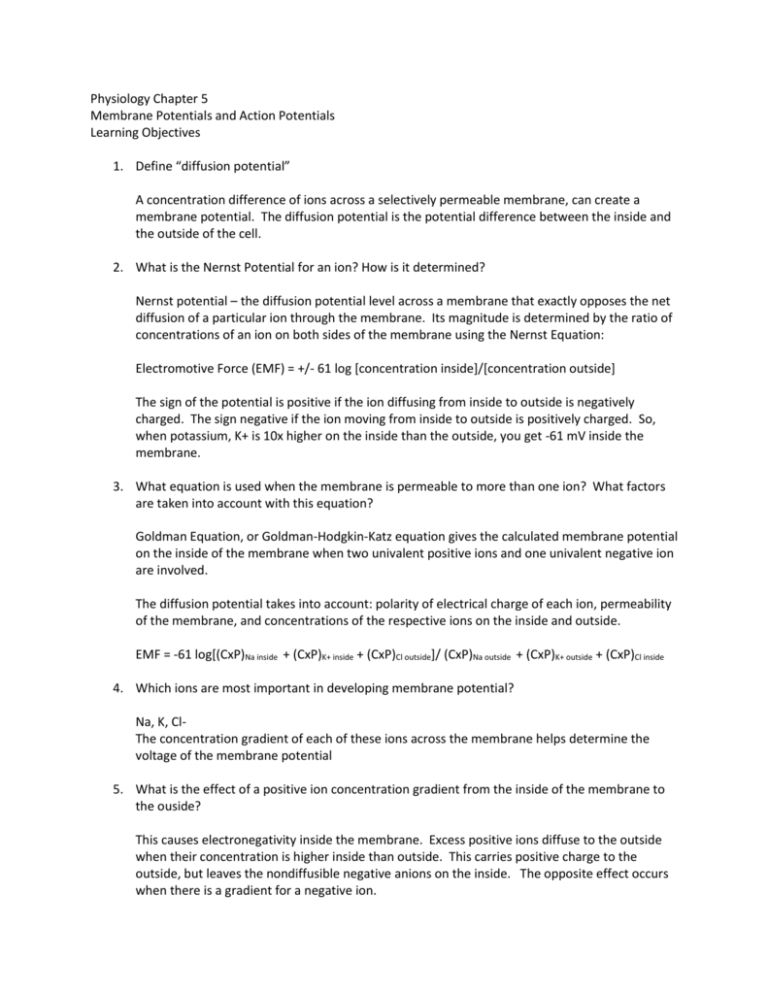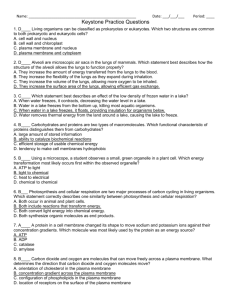phys Learning Objectives Chapter 5 [10-31
advertisement

Physiology Chapter 5 Membrane Potentials and Action Potentials Learning Objectives 1. Define “diffusion potential” A concentration difference of ions across a selectively permeable membrane, can create a membrane potential. The diffusion potential is the potential difference between the inside and the outside of the cell. 2. What is the Nernst Potential for an ion? How is it determined? Nernst potential – the diffusion potential level across a membrane that exactly opposes the net diffusion of a particular ion through the membrane. Its magnitude is determined by the ratio of concentrations of an ion on both sides of the membrane using the Nernst Equation: Electromotive Force (EMF) = +/- 61 log [concentration inside]/[concentration outside] The sign of the potential is positive if the ion diffusing from inside to outside is negatively charged. The sign negative if the ion moving from inside to outside is positively charged. So, when potassium, K+ is 10x higher on the inside than the outside, you get -61 mV inside the membrane. 3. What equation is used when the membrane is permeable to more than one ion? What factors are taken into account with this equation? Goldman Equation, or Goldman-Hodgkin-Katz equation gives the calculated membrane potential on the inside of the membrane when two univalent positive ions and one univalent negative ion are involved. The diffusion potential takes into account: polarity of electrical charge of each ion, permeability of the membrane, and concentrations of the respective ions on the inside and outside. EMF = -61 log[(CxP)Na inside + (CxP)K+ inside + (CxP)Cl outside]/ (CxP)Na outside + (CxP)K+ outside + (CxP)Cl inside 4. Which ions are most important in developing membrane potential? Na, K, ClThe concentration gradient of each of these ions across the membrane helps determine the voltage of the membrane potential 5. What is the effect of a positive ion concentration gradient from the inside of the membrane to the ouside? This causes electronegativity inside the membrane. Excess positive ions diffuse to the outside when their concentration is higher inside than outside. This carries positive charge to the outside, but leaves the nondiffusible negative anions on the inside. The opposite effect occurs when there is a gradient for a negative ion. 6. What is the theory behind measuring membrane potential? A pipette is impaled through the cell membrane to the interior fiber. Another electrode (the indifferent electrode) is placed in the ECF, and the potential difference is measured using a voltmeter. To record rapid changes in membrane potential, the microelectrode is connected to an oscilloscope. 7. Why is the Sodium-potassium pump said to be “electrogenic”? More positive charges are pumped to the outside than to the inside: 3 Na+ are pumped outside for each 2 K+ pumped in. This leaves a net deficit of positive ions on the inside, creating a negative potential inside the cell membrane. 8. What are the approximate concentrations of Na and K inside and outside the cell? What are the ratios? Na+ inside = 14 mEq/L Na+ outside = 142 mEq/L K+ inside = 140 mEq/L K+ outside = 4mEq/L The ratios are as follows Na+inside/Na+ outside = 0.1 , K+inside/K+outside = 35.0 9. How do the ions contribute to membrane potential in a normal nerve fiber? Potassium alone has a ratio of 35 from inside to outside. The log of 35 is 1.54, which taken times -61 is -94mV. Because potassium is 100x more permeable than sodium, it is the major contributing factor. However, using the goldman equation gives a potential inside the membrane of -86mV. Additionally, the Na/K pump contributes to the membrane potential, adding about -4mV, which are not accounted for by diffusion. Therefore, the net membrane potential is approximately -90mV. 10. Describe the stages of an action potential: Resting – before the action potential begins. The membrane is polarized at about -90mV Depolarization – the membrane becomes very permeable to sodium ions, allowing for the normal polarized state to become immediately neutralized by inflowing positive charges. In large nerve fibers, excess sodium moving to the inside actually causes an overshoot beyond zero and into a somewhat positive range. Repolarization – sodium channels begin to close, and potassium channels open more than normal. This re-establishes the normal negative resting potential. 11. Describe the activation and inactivation of the voltage-gated sodium chanel The channel has two gates, one near the outside (activation gate) and one near the inside (inactivation gate). In normal resting potential, the activation gate is closed, while the inactivation gate is open. Activation: membrane becomes less negative, and hits a threshold between -70 and -50mV that causes a sudden conformational change in the activation gate, flipping it all the way into open position. Sodium ions pour through the channel. Inactivation: the same increase in voltage that opens the activation gate also closes the inactivation gate, however this occurs a few 10,000ths of a second after the activation gate opens. Thus, it is a slower process than opening the activation gate. The inactivation gate will not reopen until the membrane potential returns to or near the original resting membrane potential level. 12. Describe the activation and inactivation of the voltage gated potassium channel: There is only one gate on this channel, on the inner surface of the membrane. During the resting state, this gate is closed. When membrane potential rises from -90mV toward zero, it causes a conformational opening of the gate that allows increased potassium diffusion outward through the channel. The activation occurs at approximately the same time that the sodium channels are being inactivated. 13. What are some methods for measuring the effect of voltage on opening and closing of the voltage gated channels? Voltage Clamp – won a Nobel prize for Hodgkin and Huxley; apparatus called voltage clamp measures flow of ions through different channels with two electrodes inserted into nerve fiber. One measures voltage of membrane potential, and the other conducts electrical current into or out of the fiber. When membrane potential is suddenly increased, voltage-gated sodium and potassium channels open, and ions pour through. To counterbalance, electrical current is injected automatically through the current electrode to maintain intracellular voltage at a steady zero level. Current electrode is connected to an oscilloscope that measures current flow. Selectively block one channel at a time – sodium blocked by tetrodotoxin applied to exterior of nerve fiber; potassium blocked by tetraethlaminonium ion applied to interior of nerve fiber 14. Describe the events that occur to cause an action potential: Before the potential starts, the conductance of potassium is about 100x greater than sodium because of the leak channels. An event then occurs to cause depolarization to threshold, which then changes conformation of the sodium channels to the activated state. There is an influx of sodium which depolarizes the membrane, and then sodium channels are inactivated at the same time that the potassium channels are activated to rapidly repolarize the membrane. 15. How do negative anions inside the nerve axon affect action potential? Because many ions cannot leave the interior of the axon, any deficit of positive ions inside the membrane leaves an excess of impermeant negative anions. These are responsible for a negative charge inside the fiber when there is a net deficit of positively charged potassium and other positive ions. 16. How do calcium ions affect action potential? Almost all cells have a calcium pump similar to the sodium pump. The calcium pumps ions from the interior to the exterior of the cell membrane (or into ER of the cell) causing a gradient of about 1000x. These channels are slightly permeable to sodium as well. Calcium channels are slow to activate. They are numerous in cardiac and smooth muscle. 17. What is the effect of a calcium deficit in the extracellular fluid? The sodium channels become activated by very little increase of the membrane potential from its normal, very negative level. Thus, the nerve becomes highly excitable, sometimes discharging repetitively without provocation. This can cause muscle tetany, which can sometimes be lethal. This happens because calcium ions appear to bind the exterior surfaces of sodium channel protein. The positive charges of the calcium ions alter the electrical state of the channel protein, which alters the voltage level required to open the sodium gate. 18. Explain the propagation of an action potential with the opening of sodium channels: Once the membrane hits threshold at one point, the sodium channels open. This causes adjacent membrane to depolarize and reach threshold. This is a positive-feedback vicious cycle that, once feedback is strong enough, continues until all the voltage-gated sodium channels have become activated. 19. What is threshold? This is the rise in membrane potential great enough to create the vicious cycle. It occurs when the number of Na+ ions entering the fiber becomes greater than the number of K+ ions leaving. This usually requires a sudden rise is potential of 15-30 mV. 20. What is the all or nothing principle? The depolarization process travels over the entire membrane if conditions are right, or it does not travel at all. The ratio of action potential to threshold for excitation must at all times be greater than one (the safety factor for propagation). 21. How is the Na/K ATPase affected by sodium concentration? The degree of activity is strongly stimulated when excess sodium ions accumulate within the cell membrane. Pumping activity increases to about the third power of the intracellular sodium concentration. So, if internal sodium concentration rises from 10-20mEq/L, the activity increases about eightfold. 22. Explain the presence of a plateau in action potential of heart muscle fibers These plateaus last as long as 0.2-0.3 seconds, which causes contraction to last that long. This is caused by two types of channels: the fast channels (sodium), and the slow channels (voltagegated calcium-sodium channels). Opening of the fast channels causes the spike of the action potential, but opening of the slow calcium-sodium channels allows calcium to enter the fiber. Additionally, voltage gated potassium channels may be slower than usual to open, which delays return of membrane potential to resting value. 23. Why does the membrane of the heart not depolarize immediately after it had become repolarized, rather than delaying? Toward the end of each action potential and continuting for a short period thereafter, the membrane becomes excessively permeable to potassium ions. This carries tremendous positive charge to the outside and draws potential nearer to potassiums – hyperpolarization state. 24. Describe insulation of peripheral nerves: Schwann cells have a membrane that envelopes the axon. Then the cell rotates around the axon many times, laying down multiple layers of membrane containing the lipid sphingomyelin. 25. What is salutatory conduction? Action potentials occur only at the nodes of Ranvier. They seem to jump from node to node, which causes the velocity of nerve transmission to greatly increase. 26. What causes action potentials? Mechanical disturbance of membrane Chemical effects on the membrane Electrical passage through the membrane 27. What is refractory period? Absolute refractory period – the period during which a second action potential cannot be elicited, even with a strong stimulus. This lasts about 1/2500 of a second.








